At the end of the 1600s Ulrich and his family were located in Wurttemburg, Germany. He and Anna had two daughters, Anna and Elizabeth, and a son Garrett, who were born between 1698 and 1705.
The Palatines
The Palatine region, where the Winegars settled, was torn by wars throughout most of the 1600s. The Thirty Years War was from 1618-1648. This was followed by other wars. It is estimated that as much as 50% of the population lost their lives during these conflicts. The ruler of the region broke with France, which infuriated Louis XVI. He ordered the region burned to the ground, and two cities and 25 villages were reduced to ashes. We don’t know if the Winegars lived in any of these areas.
At this time, the ruler controlled all the land. Workers were heavily taxed to support the war effort and could only buy and sell through their landlord. During 1708-1709, the region experienced a devastatingly cold winter. The rivers froze and all the crops, including the vineyards, were destroyed. Starvation was everywhere.
During this time, England was busy colonizing the New World. Queen Anne saw the Palatines as a valuable source to populate the region and create wealth for England. She had advertisements distributed throughout the Palatine region promising land in America. Facing starvation in their own land, thousands responded. The ruler prohibited migration and even threatened death to those caught leaving, but most ignored the threats.
To escape, the Palatines had to make a four to six week trip during the winter, up the Rhine River to Rotterdam, Holland. The Dutch were unprepared for all the immigrants and quickly arranged to send them on to England. England, likewise, was unable to handle so many sick and starving people. As quickly as possible, they were relocated, many to the New World. English sea captains were paid a “bounty” by the crown to recruit and transport colonists to America. The Palantines who spoke only German signed English language contracts which commited them to pay for their passage perhaps from their labor in the new world where they were promised land.
Most of the Palatines were sent to Pennsylvania, and they became known as the Pennsylvania Dutch. Ulrich and family were on the List of Palatines leaving England in June of 1709. They went to New York. On the list, Ulrich said he was 41 years old, of the Catholic Religion and gave his occupation as Husbandman and Vinedresser. Being Catholic would have been unusual in that most of the Palatines were protestants and oppression by the Catholic Church was another reason for escaping from Germany. We have no record of the family being Catholic in New York.
Conditions on the voyage were terrible. Approximately one-sixth of the passengers were buried at sea. When they arrived in the New World, the local population was so afraid of all the sickness on board that the passengers were quarantined on Governor’s Island for six months. This was the first case of a quarantine of immigrants in America.
Eventually, in 1710, they reached the area where they were to settle. The Palatines lived in camps across from each other on the Hudson River – the East Camp, where Ulrich lived with his family, and the West Camp. The East Camp came to be called Germantown, New York. It is said that, although people in the two camps could see one another across the river, they were unable to meet face to face except in the winter when they could cross on the ice. Even with today’s modern roads and bridges, the distance is 17 1/2 miles between the two camps. The campsites are memorialized in monuments, one bearing the names of the residents of the camps.
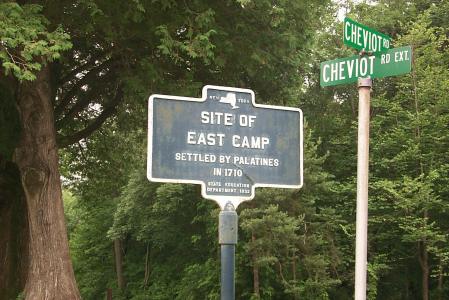
East Camp Marker. Photo by Sandra Winegar.
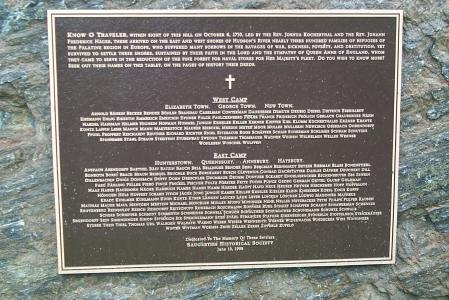
Note name "Winninger" in East Camp list, last name on second row from bottom. Photo by Sandra Winegar.
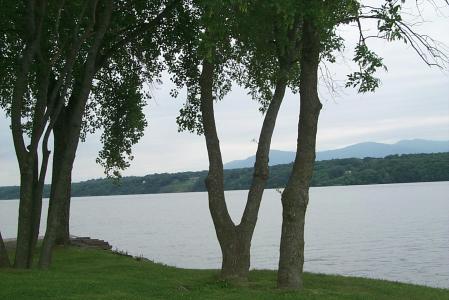
View from East Camp to West Camp across Hudson River. Photo by Sandra Winegar.
Although we have no real information on life at Germantown, we do know they became tenants to the lord of the manor, Robert Livingston. The colonists had been promised land but did not receive it until 1724, 14 years after arriving. Ulrich, bitter that others had profited unfairly from his labor, sold his land the same year and relocated to the Oblong, which is now Amenia, New York.
Amenia
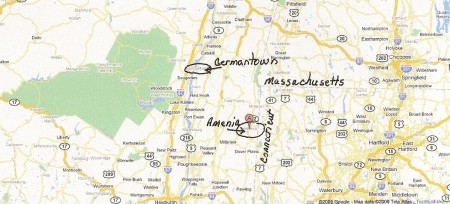
Map showing Amenia and Germantown
Ulrich, his wife, and son Garrett moved from the East Camp (Germantown) to Amenia, a distance of about 50 miles, in 1725. At the time, there was only one other white person living in the area. Ulrich obtained land from the Indians and built a house. Later, when the area became part of the colony, he was able to purchase this land at a reasonable price. Apparently, they got along very well with the Indians in that they had no need for blockhouses or forts although other nearby communities required them. We know little about Ulrich’s life in Amenia, but he was known as being a very laborious man, possessed of an iron constitution and of great muscular power.
Anna died in 1735 and Ulrich in 1750. They are buried in the family cemetery in Amenia.
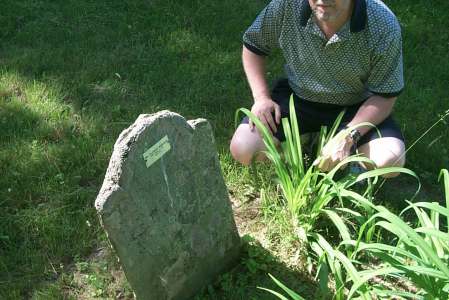
Jim Winegar at Ulrich's grave. Photo by Sandra Winegar.

Hello, I am a descendant of Elizabeth Winegar Barrett, 3/23/1790 – 1/23/1872. Her father and mother were: Ashbel d. 1809 and Lucy ___. I see you have information on an Ashbel, but with a different spouse. Also you mention a Garrett Winegar, we have a Garrett Wineger, son of Elizabeth’s brother, Uldrick. I’m just curious if there is a connection between our families? Ashbel lived in Nassau, NY. Thanks so much in advance!
Wonderful Resource!!!! Thank you for telling the Uldrich story so beautifully in words and pictures….Lee Ann Winegar Dutton Pocatello, ID
Hello, I am a descendant of Margaret Winegar 1803 – 1843 who married Peter G. Klock. Her lineage is:Philip Winegar 1752 – 1815, son of Uldric Winegar 1729 – 1812, son of Capt. Garrett Winegar 1702 – 1755, son of Uldric (Oliver) Winegar 1648 – 1754. I have been trying to get information on Mary Anna Nase 1727 – 1761 and her family. I am amazed by all your wonderful information on your blog!
Cathy Marrinan Holzwart of St. Petersburg, Florida